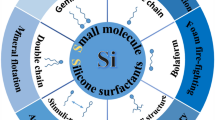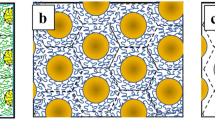Abstract
New oligofunctional surfactants prepared from ethyl 2-aminododecanoate hydrochloride and positional isomers of aromatic acid di- and trichlorides via amide bond formation, including also the monofunctional compound of comparison, have been synthesized. Surface properties of the new compounds, in particular critical micelle concentration (CMC), surface tension at the CMC, effectiveness, and maximum surface excess, were determined. Moreover, their effectiveness at flotation using the model mineral fluorite was studied. We found that the surfactant parameters clearly depend on the number and position of the amphiphilic subunits attached to the aromatic core. We also found that a bundling of amphiphilic subunits, as performed, is profitable in the flotation of fluorite and that effects of preorganization due to the proximity and geometric grouping of the amphiphilic subunits are of importance. As a rule, the more amphiphilic subunits are included in the surfactant structure, the more efficient is the collecting agent, involving approximate enhancements of fluorite flotation by powers of 10 when going from mono- to bi- and trifunctional surfactant analogs, respectively. Nevertheless, the surface properties of the newly synthesized surfactants do not directly correlate with the flotation data, which makes relations between surfactant structure and efficiency of fluorite flotation at the current stage of development difficult to determine. Future studies relating to this problem are suggested.
Similar content being viewed by others
References
Schubert, H., Aufbereitung fester mineralischer Rohstoffe, VEB Deutscher Verlag für Grundstofftechnik, Leipzig, 1979, Vol. II.
Somasunderan, P., and R. Ramachandran, Surfactants in Floration, in Surfactants in Chemical/Process Engineering, edited by D.T. Wasan, M.E. Ginn, and D.O. Shah, Marcel Dekker, New York, 1988, p. 195.
Kenny, FJ., Use of Surfactants in Mineral Flotation, in D.R. Karsa, Industrial Applications of Surfactants II, Proceeding of a Symposium Organized by the North West Region of the Industrial Division of the Royal Society of Chemistry University of Salford, 19–20 April, 1989, Special Publications, No. 77, The Royal Society of Chemistry, Cambridge, 1989.
Leija, J., The Surface Chemistry in Froth Flotation, Plenum Press, New York, 1982.
von Rybinski, W., and M.J. Schwuger, Adsorption of Surfactant Mixtures in Froth Flotation, Langmuir 2:639 (1986).
von Rybinski, W., M.J. Schwuger, and B. Dobias, Surfactant Mixtures as Collectors in Flotation, Colloids Surf. 26:291 (1987).
Helbig, C., H. Baldauf, T. Lange, R. Neumann, R. Pollex, and E. Weber, Neuartige binäre Sammlerstrukturen mit erhöhter Flotationswirkung, Tenside Surf. Del. 36:58 (1999).
Menger, F.M., and J.S. Keiper, Gemini-Tenside, Angew. Chem. 112:1980 (2000); Angew. Chem. Int. Ed. Engl. 39:1906 (2000).
Cram, D.J., Praorganisation—Von Solvenzien zu Sphäranden, Angew. Chem. 98:1041 (1986); Angew. Chem. Int. Ed. Engl. 25:1039 (1986).
Schneider, H.-J., and A. Yatsimirsky, Principles and Methods in Supramolecular Chemistry Wiley, Chichester, 2000.
Steed, J.W., and J.L. Atwood, Supramolecular Chemistry, Wiley, Chichester 2000.
Cram, D.J., From Design to Discovery, American Chemical Society, Washington, DC, 1990.
Hell, C., and S. Twerdomedow, Über einige neue Derivate der Myristinsäure, Ber. Dtsch. Chem. Ges. 22:1746 (1889).
Birosel, D.M., Certain Amino Derivatives of Lauric Acid, J. Am. Chem. Soc. 53:3039 (1931).
Krüger, G., Organische Stickstoffverbindungen IV/I, in Methoden der Organischen Chemie (Houben-Weyl), edited by D. Klamann, Thieme Verlag, Stuttgart, 1992, Vol. E16d, p. 572.
Boissonnas, R.A., S. Guttmann, R.L. Huguenin, P.-A. Jaquenoud, and E. Sandrin, Synthèse de la l-histidyl-l-phénylalanyl-l-arginyl-l-tryptophanyl-glycyl-ε-CBO-l-lysyl-l-propyl-l-valylamide, Helv. Chim. Acta 41:1867 (1958).
Grammenudi, S., and F. Vögtle, Große Molekülhohlräume für kleine Ionen—Doppelte Verbrückung dreier Bipyridin-Einheiten, Angew. Chem. 98:1119 (1986); Angew. Chem. Int. Ed. Engl. 25:1122 (1986).
Gad, E.A.M., A.M. Badawi, and M. Zaki, Surface and Thermodynamic Studies of N-Alkyl N-Trimethylsilane Ammonium Chloride Surfactants, J. Surfact. Det. 2:45 (1999).
Newkome, G.R., X. Lin, and J.K. Young, Syntheses of Amine Building Blocks for Dendritic Macromolecule Construction, Synlett:53 (1992).
Henecka, H., and E. Ott, Methoden zur Herstellung, Umwandlung und Decarboxylierung von Carbonsäuren, in Methoden der Organischen Chemie (Houben-Weyl), edited by E. Müller, Thieme Verlag, Stuttgart, 1952, Vol. 8, p. 359.
Pérez, L., A. Pinazo, M.J. Rosen, and R. Infante, Surface Activity Properties at Equilibrium of Novel Gemini Cationic Amphiphilic Compounds from Arginine, Langmuir 14:2307 (1998).
Hancer, M., and M.S. Celik, Flotation Mechanisms of Boron Minerals, Sep. Sci. Technol. 28:1703 (1993).
Baldauf, H., H. Schubert, and W. Kramer, N-Acylaminocarbonäuren—Sammler für die flotative Trennung von Fluorit und Calcit, Aufbereitungstechnik 5:235 (1986).
Author information
Authors and Affiliations
Corresponding author
About this article
Cite this article
Müller, P., Weber, E., Helbig, C. et al. Tethering of long-chain amino acids to a rigid aromatic core—A new type of preorganized surfactants acting as flotative agents. J Surfact Deterg 4, 407–414 (2001). https://doi.org/10.1007/s11743-001-0195-z
Received:
Accepted:
Issue Date:
DOI: https://doi.org/10.1007/s11743-001-0195-z




